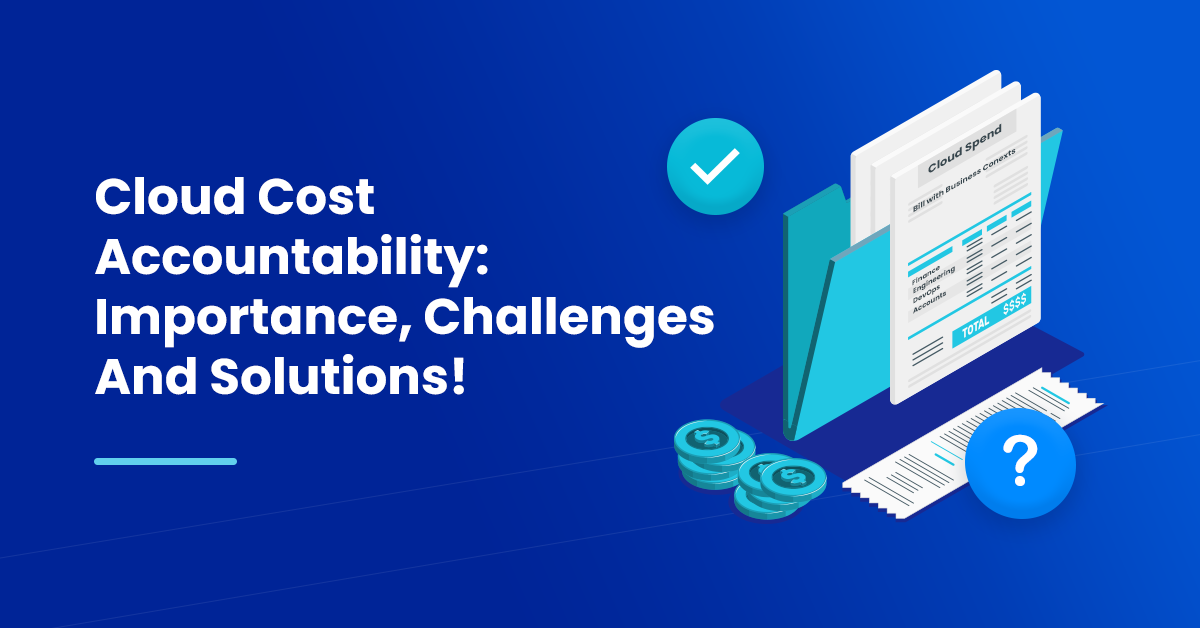Having a flexible approach towards development is all good until your team loses track of the cloud costs, and it results in a highly unexpected AWS bill! Simple formula: “You can only control what you can measure.” If you aren’t aware of what is being spent and on what and why, no good approach can help you optimize.
This is where cloud cost accountability is needed! It refers to the practice of ensuring that all cloud-related expenses are adequately monitored, managed, and allocated within an organization. It involves establishing clear ownership and responsibility for cloud spending and implementing control mechanisms to prevent unnecessary spend.
This blog explores the concept of cloud cost accountability, the potential challenges, and the counter solutions towards the same. Read through!
Understanding Cloud Cost Accountability And Its Importance!
Cloud cost accountability refers to the process of accurately tracking and monitoring the expenses associated with cloud used by an organization. It involves identifying, analyzing, and optimizing the costs of cloud services to ensure that an organization is efficiently using its resources and achieving its financial objectives.
The importance of cloud cost accountability cannot be overstated. It helps organizations identify inefficiencies in cloud usage, optimize cloud costs, and prevent budget overruns. It also enables them to accurately allocate cloud expenses to different business units and departments, providing greater transparency and accountability for cloud spend.
Cloud cost accountability is the game-saver, especially for the bigger picture. Each department can be aware of its individual costs and internal COGS, but the overall cost of doing business is not considered individually. For example, if we consider what margin the business is actually making, we cannot consider only the development expense or the marketing cost. Additionally, the shared IT cost can never be excluded. Thus, appropriate allocation and accountability help in understanding the who, what, and why attributes of cloud spend, ultimately leading to better and more efficient cost management!
What Are The Challenges To Cloud Cost Accountability?
Given the two sides of the coin, with the benefits of cloud cost accountability, there come a number of challenges as well. Here are the primary ones:
- Challenge: The foremost challenge to cost accountability is its awareness. It is not explicitly talked about, and that’s why departments are not able to understand its essence and take serious action.
Solution: Organizations should take the initiative to explain how cost accountability affects the management and can impact the margins positively. A centralized platform for Showback and Chargeback management like nOps Business Contexts helps spread awareness, as multiple users can easily be invited and see how cost structures work from the bigger picture. It helps organizations get everybody on the same page.
- Challenge: Cloud cost reports are not always openly accessible, leading to higher dependency. Additionally, not everyone understands how the Showback reports work or how they are analyzed to get the relevant information they seek.
Solution: nOps Business Contexts offers a user-friendly interface that is easily accessible and understandable. Different views and filters allow users to navigate through the cost flow and get access to the granularity. And teams can control user access with the visibility and edit capabilities differentiated.
- Challenge: Whether a surplus of people using your application or a modernization project, cloud demands are highly unpredictable. Thus, maintaining a consistent approach to cloud forecasting and budgets becomes a challenge, leading to another blocker in cost accountability.
Solution: As a solution to this, nOps helps businesses allocate every single dollar of AWS spend by handling untagged and miss-tagged resources efficiently. With every resource getting allocated to the concerned teams and projects, it becomes easier to segment cost flows on a unit economic basis and improve cloud forecasting.
- Challenge: Inconsistent tagging strategies, or even typos, and account naming are the primary concerns of cloud accounting. Each department has its own perception of costs, leading to different tags and allocation rules. This again poses a blocker towards ownership.
Solution: nOps Business Contexts allows you to merge and combine tags, to create business groups/filter out data as per the requirements. So even if you have Prod, Production, and PRD as values within your reporting system, you can see them as one value. Moreover, the platform eases access to Metadata categorized over different filters like regions, departments, projects, and many others.
- Challenge: Different departments tend to calculate cost segmentation differently. For example, tax and business support are used by everybody but may not be appropriately allocated based on usage.
Solution: nOps Business Contexts offers a standardized cost-attribution and distribution model where you can effectively tag and allocate resources. Shared costs like bandwidth and business support are also taken care of through proportionate-weightage tagging.
nOps Business Contexts: The Solution To All Cost Accountability Challenges!
nOps Business Contexts is a cloud management platform that simplifies AWS management by providing visual insights into cloud usage and cost accountability. To be precise, it helps you allocate every single dollar of AWS spend to maximize your potential.
Your team focuses on innovation, while nOps runs optimization on auto-pilot to help you track, analyze and optimize! Our customers can benefit in two key ways:
- First, pay less for what you use without the financial risk.
- Second, use less by automatically pausing idle resources.
Let us help you save! Sign up for nOps today.



